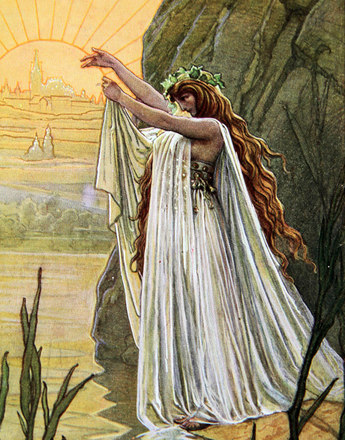The concept of ‘German Central Europe’
In the 1980s the concept of ‘Central Europe’ experienced a renaissance in intellectual circles. From the Austrian point of view ‘Central Europe’ was understood as being made up of the successor states of the Monarchy, which some romanticized as having been a happily harmonious patchwork of peoples. The term was not always understood in this way: around 1900 ‘Central Europe’ had quite a different meaning.
In the context of the European balance of power, Central Europe was seen as the counterbalance to the power blocks of France and Russia. Especially in Liberal circles in Vienna, this scenario was greatly favoured as an alternative to the greater-German solution, which would have resulted in a dividing up of the Habsburg Monarchy. The German principalities and the Habsburg lands were seen as forming one block, making up an ethnic patchwork with a total population of some 70 million in which the Germans naturally had a leading role over the smaller peoples of the region. This reflected a certain cultural chauvinism on the part of the Germans, who tended to deny that the smaller peoples had cultures of their own and thus gave themselves the credit for any kind of progress or civilizing elements. Given this ‘cultural colonialism’, it is not surprising that the smaller peoples responded with a reaction of vehement self-defence.
From the middle of the nineteenth century the nationalistically minded German elites reacted to this intensification of emancipation campaigns on the part of the non-German nationalities of the Monarchy with demands for a strengthening of the German character of the Monarchy (or, after 1867, of Cisleithania), in particular through the introduction of German as the official state language as a means of consolidating and preserving the supremacy of the German language and culture.
A similar policy was pursued in Berlin. The German concept for Central Europe emphasized most especially such initiatives as a customs union, in which the leading role would as a matter of course be performed by Germany as the stronger and economically more powerful partner. Austria-Hungary was to act as a bridge to the Balkan region, which was to be exploited in a quasi-colonialist manner. Even now, an Austria suitably strengthened in its German-ness was being referred to as the ‘Ostmark’. At the right-hand end of the German political spectrum the policy was also understood as being oriented towards the subjection and Germanization of the smaller nations of Central Europe. In August 1914, the war was seen as an opportunity to bring these plans to fulfilment.
This attitude was also prevalent in the German nationalist movement in the Habsburg Monarchy. In 1915, the Association of German Nationalists drew up a document (the ‘Osterbegehrschrift’) expressing certain basic principles and the demand that the rights of the non-German nationalities should be cut back and the Austro-German alliance written into the constitution. Once the war had been brought to a successful conclusion, the ground would thus have been laid for a thorough reorganization of the Monarchy in which Dualism would be reduced to the fact of the personal union with Hungary and the non-German-speaking crown lands such as Galicia or Dalmatia relinquished or turned into autonomous federal states with a status similar to that of Croatia within Hungary. By virtue of the large majorities in the Danube, Alpine and Sudeten areas Austria would now be more concentratedly German and the way would be open for the enforced Germanization of the Czechs and Slovenes.
While these radical demands were rejected by the moderates, they did nevertheless elicit certain concrete reactions, as a strengthening of the German element was definitely in the interest of the Cisleithanian government. Even as late as April 1917 Minister-President Clam-Martinic tried to exploit the long-standing suspension of the Reichsrat to create a new and irreversible situation. He planned to introduce German as the sole official language in the Austrian half of the Monarchy, to make Galicia autonomous, which would have boosted the proportion of Germans in Austria, and to redraw the administrative boundaries of the Bohemian lands in clear accordance with ethnic majorities.
Emperor Karl, however, rejected these far-reaching changes to the structure of the Habsburg Monarchy and effectively pre-empted them by reconvening the Reichsrat. In so doing, of course, he gave back a political voice to the non-German nationalities, none of whom were by this stage in favour of continuing their existence under the rule of the double-headed eagle.
Translation: Peter John Nicholson
Kapp, Richard W.: Bethmann-Hollweg, Austria-Hungary and Mitteleuropa 1914–1915, in: Austrian History Yearbook, Bd. 19, 1983, 215–236
Křen, Jan: Dvě století střední Evropy [Zwei Jahrhunderte Mitteleuropas], Praha 2005
Rauchensteiner, Manfried: Der Erste Weltkrieg und das Ende der Habsburgermonarchie 1914–1918, Wien u. a. 2013
Rumpler, Helmut: Eine Chance für Mitteleuropa. Bürgerliche Emanzipation und Staatsverfall in der Habsburgermonarchie [Österreichische Geschichte 1804–1914, hrsg. von Herwig Wolfram], Wien 2005
-
Chapters
- The German-Austrians in the Habsburg Monarchy
- German Austrians or Austrian Germans?
- Holding the Monarchy together: The German-Austrians as the guarantors of Habsburg statehood
- In search of the Fatherland: The genesis of the German nation
- To join or not to join? Austria and the process of German unification
- Fear of losing hegemony: The German-Austrians in the Austrian multi-national state
- The radical German nationalists and their attitude to the Habsburg Monarchy
- The concept of ‘German Central Europe’
-
Chapters
- The drive for unification
- The radical German nationalists and their attitude to the Habsburg Monarchy
- The concept of ‘German Central Europe’
- Together we are strong: Pan-slavism and "Slavdom"
- The rise and fall of Austro-Slavism
- "Two branches of one nation" – Czechoslovakism as a political programme
- Viva l’Italia! Italian irredentism and the Habsburg Monarchy
- From Illyrism to Yugoslavism: competing concepts for a southern Slav nation
- Élyen a Magyar – long live the Magyars! Hungarian Magyarization policy







